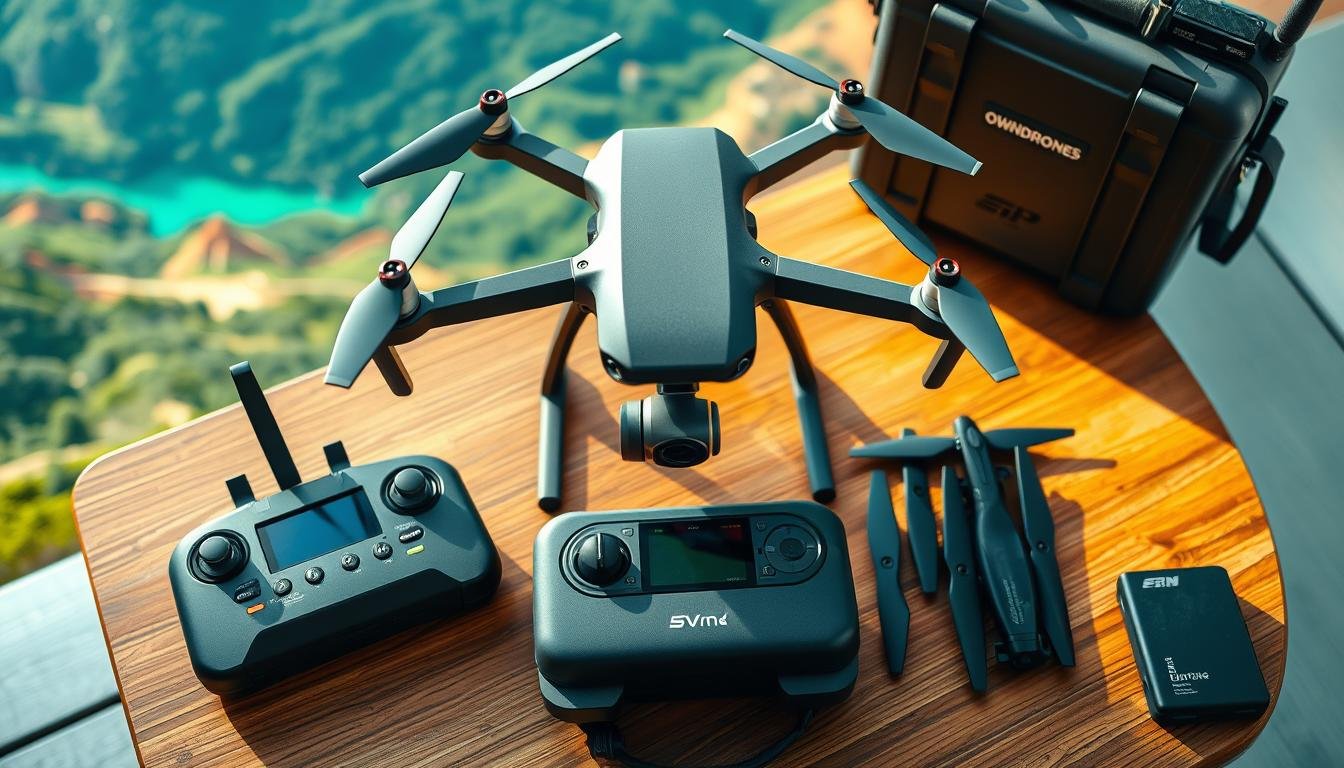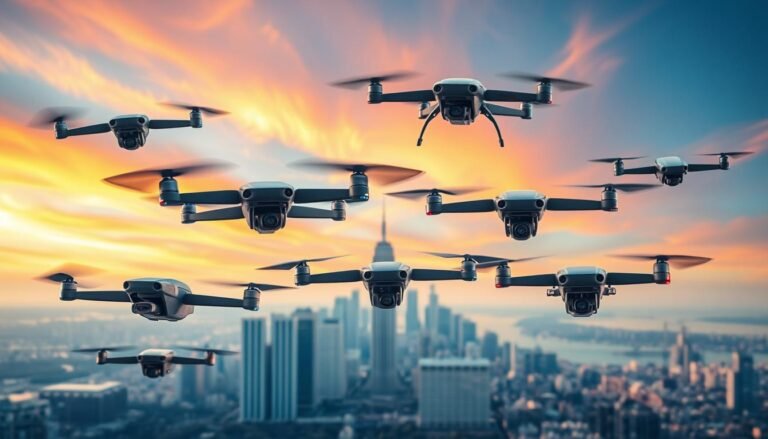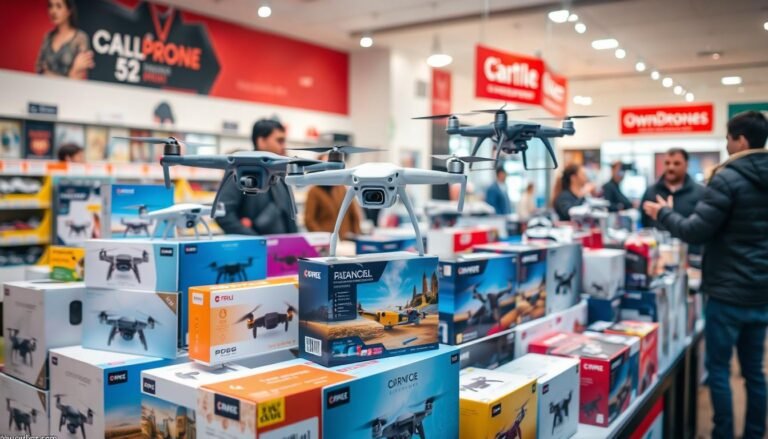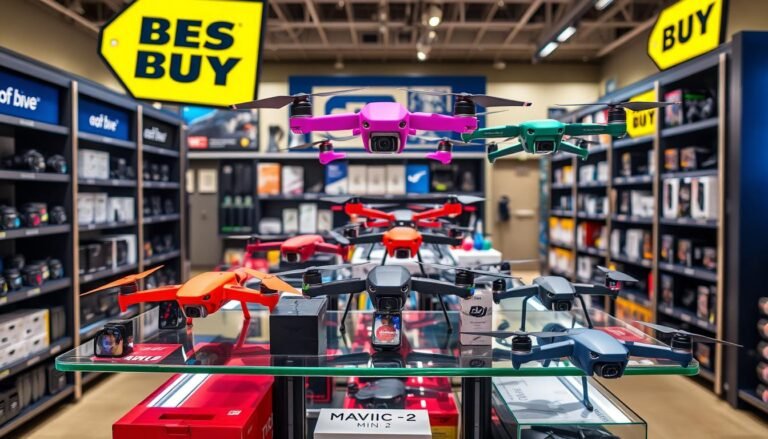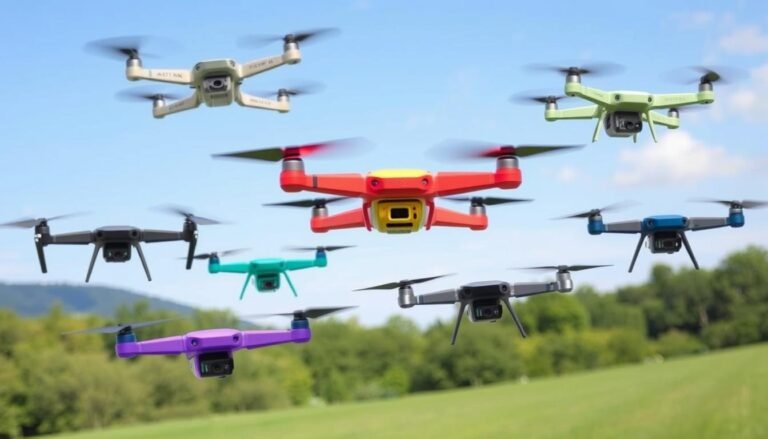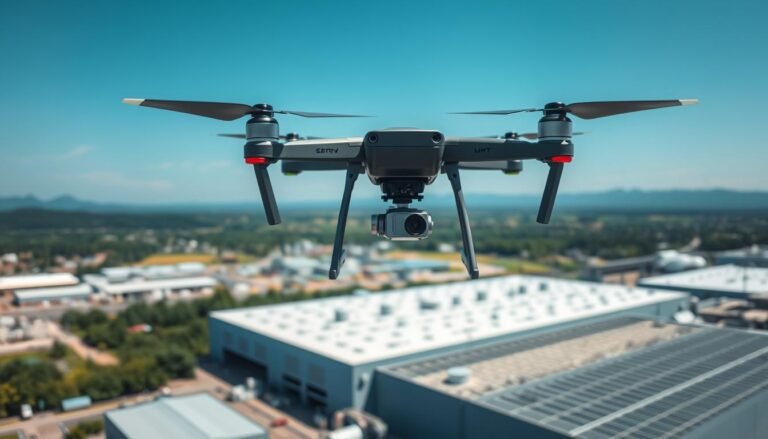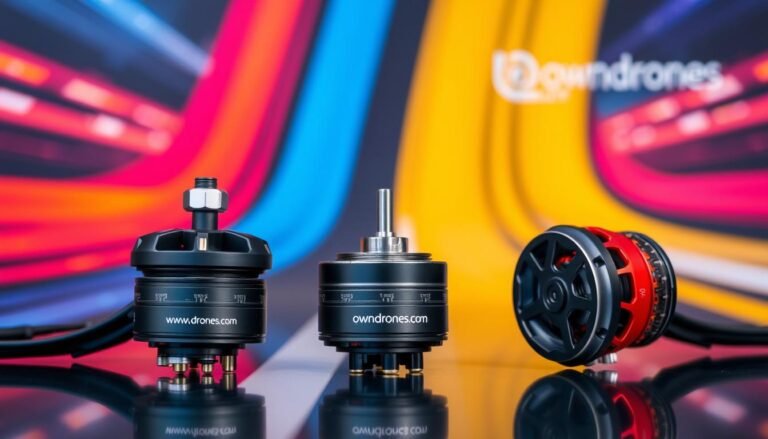Essential Drone Photography Equipment Guide for Creators
Drone photography offers a unique view from above. It’s changed how we capture aerial images and videos. Choosing the right equipment can be tricky with so many options available.
The right gear is key for stunning aerial shots. High-quality camera drones and accessories like gimbals and filters are essential. These tools can elevate your aerial photography game significantly.
The DJI Mavic Pro 3 has impressive features. It boasts a 20MP 5.1K Hasselblad camera and 43 minutes of flight time. The DJI Mini Pro 4 is lightweight and legal in most countries.
Accessories are just as important as the drone itself. Extra batteries, protective cases, and ND filters enhance your experience. They help you capture the perfect shot in various conditions.
Drone photography is gaining popularity across industries. It’s used in real estate, weddings, and more. Having the right equipment is crucial for success in this field.
This guide covers everything you need to know. It’s perfect for beginners and professionals alike. Get ready to capture the world from a whole new perspective!
Key Takeaways
- Invest in a high-quality camera drone with features like 4K video and 20MP photos for optimal results.
- Consider the flight time and weight of the drone, with models like the DJI Mavic Pro 3 and DJI Mini Pro 4 offering impressive specs.
- Essential accessories such as gimbals, ND filters, extra batteries, and protective cases can enhance your drone photography experience.
- Shoot in RAW format and maintain a low ISO setting for maximum post-processing flexibility and image quality.
- Follow safety protocols and adhere to rules and regulations when flying drones to ensure safe and responsible operation.
Introduction to Drone Photography
Drone photography has changed how we capture aerial images and videos. It combines unmanned aerial vehicles (UAVs) with high-quality cameras for stunning sky views. What is drone photography? It’s using camera-equipped drones to take photos and videos from unique angles.
Aerial photography with drones has transformed many industries. These include real estate, event coverage, and environmental monitoring. Drone Industry Insights reports that videography is a top commercial drone service.
Pilots can earn between $25,000 and $250,000 yearly. The global aerial imaging market was worth $3 billion in 2022. It’s expected to reach $28 billion by 2032, growing 22% annually (CIPA).
The Versatility of Drone Cameras
Modern drone cameras now rival DSLRs or mirrorless cameras. They often have fast superzoom lenses and optical image stabilization. Mechanical stabilization via gimbals is also common.
Drone camera sensors are small, usually one to two inches. Despite this, they produce impressive results. Quadcopters are the most popular drones for photography.
“Drones have democratized aerial photography, making it accessible to a wider range of creators and businesses.”
Quadcopters are fast, nimble, and easy to use. Fixed-wing drones offer longer flights and higher speeds. They can carry advanced camera equipment for military and commercial projects.
Drone photography offers many shooting modes, including manual for high contrast scenes. This opens up endless creative possibilities. Beginners and pros alike can explore the world of aerial photography.
Choosing the Right Drone for Photography
Picking the perfect drone for aerial photography can be tricky. Key factors include camera quality, flight time, battery life, and safety features. Understanding drone types and features will help you make the best choice.
Types of Photography Drones
Photography drones come in various categories. Consumer drones are affordable, portable, and easy to use. They’re great for hobbyists and beginners.
Professional drones offer advanced features but cost more. They’re mainly used for commercial purposes like delivery, surveying, and construction monitoring.
Key Features to Consider
When choosing a photography drone, focus on these important features:
- Camera Quality: Opt for drones with high-resolution cameras. Look for at least 12 megapixels and 4K video capability.
- Flight Time and Battery Life: Most consumer drones fly for 20-30 minutes per charge. Advanced models can last up to 46 minutes.
- Stabilization: Three-axis gimbals help stabilize cameras during flights. They ensure smooth footage even in windy conditions.
- Safety Features: Look for obstacle avoidance sensors, Return-to-Home function, and geo-fencing. These features make flying safer and more controlled.
Budget vs. Professional Drones
Consider your skill level and needs when choosing between budget and professional drones. Brands like DJI, Parrot, and Yuneec offer options for various budgets and skill levels.
| Drone Model | Max Flight Time | Transmission Distance |
|---|---|---|
| DJI Mavic 3 Pro | 43 minutes | 15 km |
| DJI Air 3S | 45 minutes | 20 km |
| DJI Avata 2 FPV | 24 minutes | 13 km |
| DJI Mini 4 Pro | 34 minutes | 20 km |
Understanding drone types and key features will help you choose the right one. Consider your needs and budget to find the perfect drone for your aerial photography adventures.
Essential Camera Gear for Drone Photography
High-quality drone camera gear is vital for stunning aerial images. The right aerial cameras and drone camera lenses can transform your photography.
Key factors to consider when picking a drone camera include:
- Resolution: Look for cameras with high megapixel counts for detailed images.
- Sensor size: Larger sensors, such as those found in full-frame cameras, perform better in low-light conditions.
- Shutter speed: Fast shutter speeds help freeze motion and reduce blur in aerial shots.
- ISO range: A wide ISO range allows you to capture images in various lighting conditions.
Sony, Canon, and Nikon are top camera brands for drones. Sony and Canon lead the market. Sony cameras have better battery life with NP-FZ100 batteries.
Full-frame cameras are often preferred by serious photographers. They offer better lens options and overall quality compared to crop sensor cameras.
| Brand | Camera Model | Sensor Type | Megapixels |
|---|---|---|---|
| Sony | Sony A7R IV | Full-frame | 61.0 |
| Canon | Canon EOS R5 | Full-frame | 45.0 |
| Nikon | Nikon Z7 II | Full-frame | 45.7 |
High-quality drone camera lenses are crucial for sharp, detailed images. Choose lenses that fit your drone and match your photography needs.
Quality and durability are key when selecting camera gear for drone photography. Stick with respected and established brand names for both cameras and lenses to ensure reliable performance and longevity.
Stay within your budget when buying drone camera gear. Invest in equipment that meets your needs and ensures a good return on investment.
Drone Gimbals and Stabilizers
Stability is crucial for capturing stunning aerial footage with your drone. Drone gimbals and camera stabilizers keep your camera steady and level. These accessories ensure smooth, professional-quality video and photos, even in challenging wind conditions.
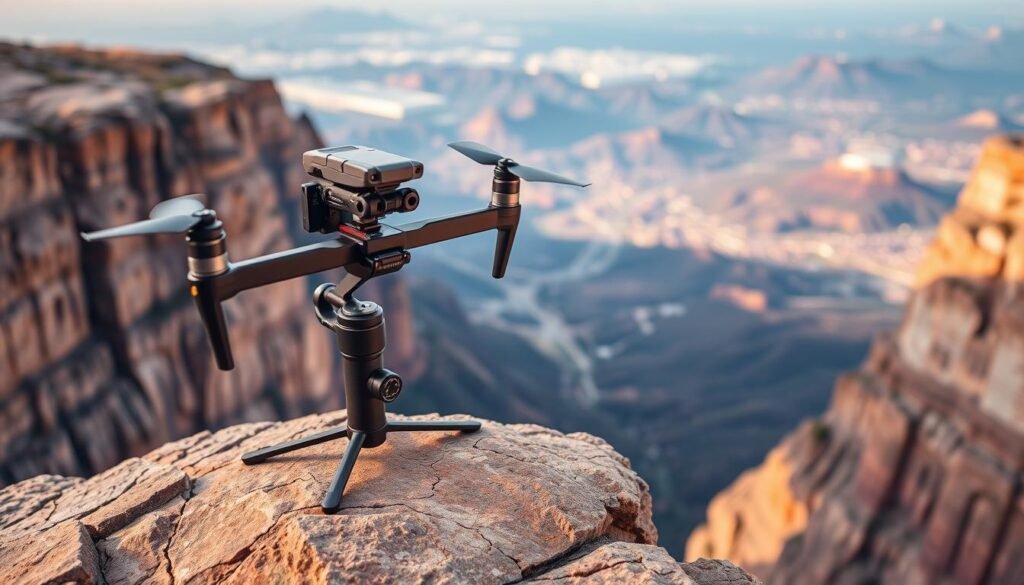
Finding the right drone gimbals for photography involves several factors. Consider compatibility with your drone model, weight capacity, and level of stabilization. Popular gimbal options include:
- DJI Zenmuse X7: A high-end gimbal designed for professional cinematography
- Zhiyun Crane 2: A versatile handheld gimbal that can also be mounted on drones
- FeiyuTech AK4000: A lightweight, compact gimbal suitable for a variety of drone models
Your aerial photography projects have specific needs. Consider these key features when selecting a gimbal:
| Gimbal | Weight | Compatibility | Stabilization |
|---|---|---|---|
| DJI Zenmuse X7 | 449g | DJI Inspire 2 | 3-axis |
| Zhiyun Crane 2 | 1250g | Various cameras | 3-axis |
| FeiyuTech AK4000 | 1200g | Various cameras | 3-axis |
A quality drone gimbal can greatly improve your aerial photography. It minimizes camera shake and vibration for better footage. You’ll capture unique perspectives that only drones can offer.
Drone Photography Accessories
The right accessories can boost your drone photography skills. Extra batteries, protective cases, and ND filters can improve your aerial shots. Let’s look at some must-have accessories for drone photographers.
Extra Batteries and Chargers
Extra batteries are vital for drone photography. They let you fly longer and take more amazing aerial shots. Quality chargers keep your batteries ready for action.
Invest in top-notch batteries and chargers. They ensure your drone performs well and lasts longer.
Protective Cases and Backpacks
Safeguarding your drone and gear is key when traveling or shooting. Sturdy cases and backpacks offer safe, easy transport for your equipment.
Look for cases with foam inserts or adjustable sections. These securely hold your drone, batteries, and other items.
Choose a backpack with padded straps and weatherproof material. It provides comfort and protection during your photo trips.
ND Filters and Lens Accessories
ND filters are game-changers for drone photography. They control light entering the camera lens, allowing smoother motion and long-exposure effects.
Lens add-ons like UV filters and polarizers protect your lens. They also boost image quality by reducing glare and enhancing colors.
| Accessory | Benefits |
|---|---|
| Extra Batteries | Extend flight time, capture more shots |
| Protective Cases | Safe transport, protection from elements |
| ND Filters | Control light, enable creative effects |
| Lens Accessories | Protect lens, enhance image quality |
Drone accessories offer many perks for photographers. They help you get the most from your drone and protect your investment.
With the right gear, you can fly longer and capture stunning visuals. Accessories can take your aerial photography to new heights.
drone photography equipment
The right drone gear is crucial for amazing aerial shots. Various options suit different skill levels and budgets. Let’s explore some top choices for beginners and pros alike.
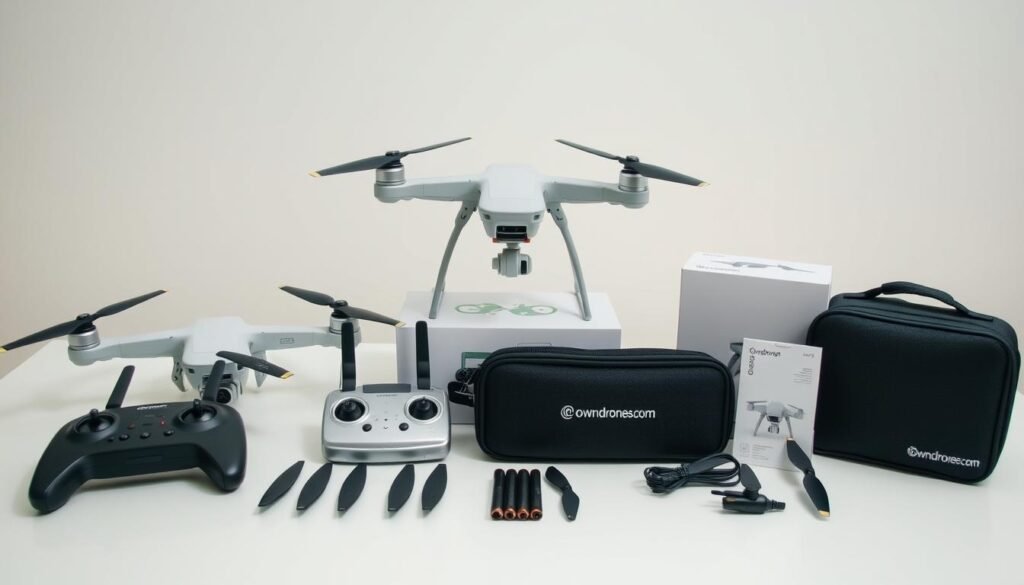
Recommended Kits for Beginners
Starter kits are perfect for newcomers to drone photography. They usually include a drone, camera, and basic accessories. The DJI Mini 4 Pro is a popular choice for beginners.
This lightweight drone weighs just 249g. It boasts 4K video resolution and a 48MP camera. With a 34-minute battery life, it’s ideal for extended shoots.
The Mini 4 Pro offers collision sensors and AI capabilities. It can shoot 4K at 60fps with optical portrait mode. These features make it great for capturing high-quality footage.
When choosing drone equipment, consider these factors:
- Ease of use and user-friendly features
- Camera quality and resolution
- Battery life and flight time
- Portability and weight
- Price point and value for money
Advanced Equipment for Professionals
Pro photographers need top-notch gear for the best results. Professional drones often have larger image sensors and stable gimbals. They also feature obstacle avoidance and intelligent flight modes.
Here are some popular options for pros:
| Brand | Model | Key Features | Price Range |
|---|---|---|---|
| DJI | Mavic 2 Pro | Hasselblad camera, 1″ CMOS sensor, 10-bit Dlog-M color profile | $1,500 – $3,000 |
| Autel Robotics | EVO II Pro | 6K video, 1″ sensor, 360° obstacle avoidance | $1,500 – $2,000 |
| Freefly Systems | Alta 8 | Heavy-lift octocopter, modular design, compatible with various cameras | $10,000+ |
Pros may also invest in specialized gear like thermal cameras. DJI and Teledyne FLIR offer thermal imaging solutions for different drone models. These provide versatile tools for professionals needing detailed thermal data.
Drone photography equipment has evolved significantly over the years, shifting from novelty gadgets to essential creative tools for photographers and filmmakers.
When picking pro drone gear, think about camera quality and gimbal stability. Flight performance and compatibility with existing equipment are also important. The right tools will help you capture stunning aerial visuals.
Drone Camera Settings and Techniques
Mastering drone camera settings is key for stunning aerial shots. Adjust ISO, shutter speed, aperture, and white balance for full control. These parameters shape the quality and style of your images.
Frame rate impacts the look of your drone footage. Different rates suit various applications.
| Frame Rate | Application |
|---|---|
| 24fps | Common for movies and cinematic look |
| 30fps | Frequently used with 4K camera drones |
| 60fps | Ideal for capturing high-speed sports and action |
Aperture affects depth of field and exposure. Different scenarios need specific aperture ranges:
- Landscape photography: f/8 to f/11
- Action scenes: f/2.8 to f/5.6
- Urban environments: f/5.6 to f/8
Shutter speed is crucial for sharp images and motion blur effects. Short speeds reduce blur in wind. ND filters allow slower speeds in bright light for cinematic blur.
Practice smooth flying and use intelligent flight modes to improve your shots. Master orbits, parallax effects, and dolly zooms for a pro touch. Fly during golden or blue hour for stunning results.
Symmetry and patterns create visually striking footage. Use different camera angles and movements for creative shots.
Refine your drone camera settings and aerial photography techniques for awe-inspiring visuals. Explore drone photography tutorials to enhance your skills further. Take your aerial imagery to new heights.
Aerial Photography Composition Tips
Boost your drone photography skills with top-notch composition techniques. These simple principles can turn ordinary shots into extraordinary images. Learn how to create stunning aerial photos that captivate viewers.
Rule of Thirds in Drone Photography
The rule of thirds is key to enhancing drone photography composition. Picture a 3×3 grid on your frame. Place important elements along the lines or at intersections.
This method creates balanced, eye-catching images. It guides viewers’ attention to the main subject effectively.
Leading Lines and Symmetry
Use leading lines and symmetry to add depth to your aerial photos. Look for natural or man-made lines that point to your main subject. Roads, rivers, or buildings work well.
Symmetrical patterns create harmony in drone shots. Try capturing reflections or geometric shapes for balanced images.
Capturing Unique Perspectives
Drone photography offers views impossible from the ground. Try bird’s-eye views, low-angle shots, and unusual angles. These add creativity to your aerial images.
Here are tips for unique drone perspectives:
- Shoot at various altitudes to showcase different levels of detail and scale
- Utilize the drone’s tilting gimbal to capture diagonal or top-down views
- Play with shadows and lighting to create dramatic and moody shots
- Look for patterns, textures, and repetition in landscapes and urban environments
Study successful drone photographers’ work to improve your skills. Notice how they use composition techniques to create compelling images.
| Composition Technique | Key Points |
|---|---|
| Rule of Thirds | Position key elements along the 3×3 grid lines or intersections for balance and visual appeal |
| Leading Lines | Use natural or man-made lines to guide the viewer’s eye and add depth to the image |
| Symmetry | Incorporate symmetrical patterns for a sense of harmony and balance in your shots |
| Unique Perspectives | Experiment with bird’s-eye views, low-angle shots, and unconventional angles for creative and interesting images |
Practice these aerial photography tips regularly. You’ll soon capture unique images that stand out from the crowd. Keep honing your skills to create truly exceptional drone photos.
Drone Photography Post-Processing
Editing your drone photography is crucial for exceptional images. The right aerial photo editing software can enhance colors and adjust exposure. These techniques can add creative touches to your photographs.
Essential Editing Software
Adobe Lightroom and Photoshop are popular for comprehensive editing capabilities. DaVinci Resolve offers a free option for color grading and post-processing. Shoot in RAW format for full access to your camera’s dynamic range.
Photogrammetry software creates 3D maps or models from multiple overlapping photographs. Drones have made collecting high-resolution aerial imagery more accessible and cost-effective. This technology is useful even in challenging areas.
Color Correction and Exposure Adjustments
Color correction for drone photos ensures accurate and vibrant hues in aerial shots. Start by adjusting white balance to neutralize color casts. Use the Dehaze tool in Lightroom to remove haze and improve clarity.
Fine-tune exposure, contrast, and tone curve to make your images pop. Shoot at the lowest ISO possible to minimize color distortion and unwanted grain.
“The key to successful drone photography editing is to find the right balance between enhancing the image and maintaining its natural essence.” – Professional Aerial Photographer
Experiment with sharpening techniques to bring out details, but avoid artifacts. Use the ‘J’ shortcut in Lightroom to highlight areas with lost color information. Adjust settings gradually to achieve your desired result.
High-quality filters, like those from PolarPro, can control reflections and enhance image quality. Practice and experiment to develop your unique editing style. This approach will elevate your drone photography.
Drone Photography Safety and Regulations
Safety and compliance are key in drone photography. Learn local and federal laws to ensure responsible aerial photography. Familiarize yourself with regulations to avoid legal issues.
The FAA sets guidelines for drone pilots in the US. Drones over 0.55 pounds must be registered. All drones should fly below 400 feet and within the pilot’s sight.
Recreational pilots must take the TRUST exam and fly in uncontrolled airspace. Commercial operators need a Remote Pilot Certificate. This allows night flights, over people, and moving vehicles.
Foreign pilots visiting the US have specific rules. Recreational flyers use the FAA’s DroneZone portal. Commercial operators need a foreign aircraft permit from the DOT.
Stay updated on drone safety and drone regulations. Prioritize safety, get necessary licenses, and respect privacy. Follow FAA drone rules to capture stunning aerial images responsibly.
Conclusion
Drone photography has transformed aerial image capture. It offers endless creative possibilities and unique perspectives. With the right equipment and skills, you can create stunning visuals from above.
Modern drones with high-res cameras have made aerial photography more accessible. This has reduced costs and eliminated the need for large crews. Small businesses, hobbyists, and professionals can now explore new opportunities in various industries.
Safety and legal compliance are crucial in drone photography. Stay informed about regulations to ensure responsible operations. Keep up with industry trends and invest in quality gear.
Practice and refine your techniques consistently. With dedication, you’ll capture the world from above in captivating ways. Your unique vision will leave a lasting impact on your audience.
